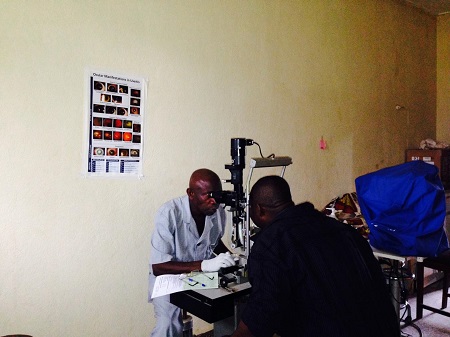Findings suggest virus lives longer in certain body fluids.
St. Michael's Hospital - TORONTO, --The largest study of survivors of the largest recorded outbreak of Ebola Virus Disease found they commonly reported complications such as vision, hearing and joint pain problems up to months after they were discharged from an Ebola treatment facility.
The findings, published today in the journal Lancet Infectious Diseases, are based on clinical and laboratory records from patients at the EVD Survivor Clinic in Port Loko, Sierra Leone, one of the West African countries hardest hit by the Ebola outbreak that began in December 2013.
The clinic, run by non-governmental organizations under the oversight of the Sierra Leone health ministry, provided clinical care for 603 of the 661 survivors of Ebola living in the Port Loko district, about 45 kilometers east of Freetown, the capital of Sierra Leone.

The largest study of survivors of the largest recorded outbreak of Ebola virus disease found they commonly reported complications such as vision, hearing and joint pain problems up to months after they were discharged from an Ebola treatment facility. Shown here is study co-author and ophthalmic nurse Amadu Kamara, Baptist Eye Hospital Lunsar, Port Loko, Sierra Leone. Photo by Dr. Sharmistha Mishra.
Among 277 survivors studied in March and April of this year, complications were common, said Dr. Sharmistha Mishra, the senior author of the paper and an infectious diseases physician at St. Michael's Hospital in Toronto.
The authors said 76 per cent of the survivors reported joint pain, 60 per cent reported new vision problems ,18 per cent had an eye inflammation (some potentially sight-threatening), and 24 per cent had hearing problems. The median time between their discharge from an Ebola treatment facility to their followup appointment at the survivor clinic where they reported these symptoms was 122 days.
Patients who had a higher Ebola viral load when diagnosed with the diseases had a higher rate of eye inflammation and new vision problems, said Dr. Mishra, who spent five months working as a World Health Organization clinical consultant for the Ebola response in Sierra Leone. The survivor clinic was jointly run by the Boston-based Partners in Health, Sierra Leone Association of Survivors in Port Loko, GOAL Global, International Medical Corps, Christian Blind Mission, and the Sierra Leone Ministry of Health and Sanitation.
The authors said the findings may suggest that while the Ebola virus is rapidly cleared from most bodily fluids after resolution of the acute disease, it might persist in "immunologically privileged sanctuary sites" -- certain bodily fluids such as semen and the vitreous humour fluid of the eyeballs. However, their study did not look for persistence of virus.
She said the findings also underline the need for followup care in West Africa, to make sure these complications are diagnosed and treated. She noted there was no systematic clinical care for Ebola survivors in the early part of the outbreak in Sierra Leone due to the overwhelming need to care for those with acute disease.
Furthermore, there are only two ophthalmologists (the lead authors of the study) and eight mid-level ophthalmological providers in the country's National Eye Health Program. Access to eye health care is further restricted by lack of equipment and medications and by the mobility of clinicians and patients. The two ophthalmologists, Dr. Matthew Vandy of the Sierra Leone National Eye Health Program, and Dr. John Mattia, of the Christian Blind Mission Sierra Leone, are the lead authors of the study.
This study received funding from the Canadian Institutes of Health Research Innovative Ebola Research Grants.
About St. Michael's Hospital
St. Michael's Hospital provides compassionate care to all who enter its doors. The hospital also provides outstanding medical education to future health care professionals in more than 23 academic disciplines. Critical care and trauma, heart disease, neurosurgery, diabetes, cancer care, and care of the homeless are among the Hospital's recognized areas of expertise. Through the Keenan Research Centre and the Li Ka Shing International Healthcare Education Center, which make up the Li Ka Shing Knowledge Institute, research and education at St. Michael's Hospital are recognized and make an impact around the world. Founded in 1892, the hospital is fully affiliated with the University of Toronto.
Source: https://www.eurekalert.org/pub_releases/2015-12/smh-lso121815.php

